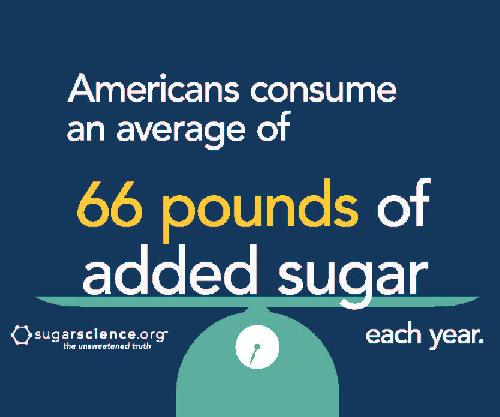One New Year’s resolution we should all make, and keep
Decrease the amount of added sugar you ingest.

It is a fact that we all know, or have at least heard – added sugars in our diet increase our chances of acquiring a chronic disease such as heart disease, diabetes and increase obesity rates in adults and children. If there’s one thing you can do this year to improve your health, resolve to cut back on the amount of added sugar in your diet.
First off, do we really even know what “added sugar” is? Although there is no universal definition, added sugars generally include all monosaccharides (glucose, galactose and fructose) and disaccharides (sucrose, or table sugar, lactose and maltose) that are added to food by the manufacturer, cook or consumer. There are over 61 different names for sugar, but one way to identify many of them is to consider anything on a food label that ends with “ose” to be an added sugar.
How much sugar can we/should we have? Currently, Americans are consuming between 19 and 22 teaspoons of added sugar every day. You may be surprised to learn that unlike other food additives such as salt and fat, there are no dietary guidelines in the U.S. for daily sugar intake. Despite conflicting research on how much is okay to consume, the American Heart Association recommends limiting added sugar to less than six teaspoons/day (25 grams) for women, three to six teaspoon (12-25 grams) for children and nine teaspoons (36 grams) for men. Other organizations, such as the World Health Organization (WHO) support these numbers.
Easy, just cut out desserts, sugary breakfast cereals and milkshakes, right? Think again! Even foods typically thought of as “healthy” can be laden with added sugars. An organization called Sugar Science states that 74 percent of added sugar comes from packaged foods both sweet and savory. For example, some popular brands of yogurt contain seven teaspoons of sugar per serving. Sugar is also hidden in foods like pasta sauce, granola bar and bread. Beverages contain huge amounts of sugar, especially soda, energy drinks, coffee drinks, juices and sweetened teas. These drinks range from about 11 to 14 teaspoons of sugar each, therefore drinking one of these in a day already doubles your added-sugar limit, depending on age and gender.
I know what you’re thinking, I put fruit juices in the “bad” category for sugar, but you’ve heard that “100 percent juice” is just like having a serving of fruit, and is a “good” sugar. While it’s probably true that 100 percent juice is better than an all-added-sugar fruit drink, the WHO wants us to go one step further and consider reducing what they call free sugars, which include all the sugars discussed above plus sugars in honey, syrups and fruit juice, basically, all the sugars in foods except for those in whole fruits and vegetables (often referred to as intrinsic sugars). The main difference between free/added sugars and intrinsic sugars is that intrinsic sugars are digested more slowly by the body, thus slowing their entrance into the blood stream. In contrast, some studies are showing that honey or real maple syrup, while they won’t decrease your calorie count, they do contain amino acids, vitamins and minerals that are beneficial to the body. Some studies also show that sugars like honey contain anti-oxidants that may help prevent heart disease and high cholesterol.
It is highly improbable that we’re all going to go off “free sugar” completely in the New Year, but there are several ways to significantly reduce the amount of added sugar in your diet. Michigan State University Extension recommends:
completely in the New Year, but there are several ways to significantly reduce the amount of added sugar in your diet. Michigan State University Extension recommends:
- Cutting back or eliminating sugary drinks. This can be a tough process as our bodies are used to getting that sugar buzz throughout the day. Start small, such as only having one soda instead of three per day or only buy the drinks in small quantities (or re-package them in your own smaller containers at home) and limit yourself to one per day. Water down sports drinks and sweet teas and limit how much you drink.
- Become a label reader. The best way to know if there’s added sugar is to read the label on all foods. Don’t be fooled by gimmicks like “all natural” or “no high fructose corn syrup.” Sugars have different names, so be sure to look for the “ose” words that will alert you to the presence of sugars.
- Convert the grams of sugar in your food to a more visual equivalent like teaspoons. This will give a better idea of how much is really in there. The general rule of thumb is to divide the grams of sugar by four to get the number of teaspoons. Example: 20 grams of sugar would equal about 5 teaspoons. Also remember that food labels give the amount of sugar per serving, and that there may be more than one serving in the container. If you eat/drink the whole container you need to multiply the number of teaspoons by the number of servings. Example: 20 grams sugar per serving, 3 servings per container would equal 15 teaspoons of sugar if you ate the whole thing.
- Make substitutions. When baking and cooking consider substituting refined or white sugar, with honey or maple syrup. These won’t reduce the calories of the food, but you’ll at least be getting some other nutrients along with the sweetness. Also keep in mind that honey and maple syrup taste sweeter and don’t need to be used 1-to-1 in substitutions. Start with a little and add more to taste.



 Print
Print Email
Email




